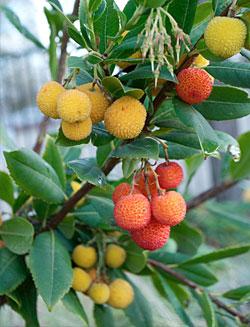Water-Efficient Landscape Gardens in January
Home » Fair Oaks Horticulture Center » WEL Gardens » January in the WEL
The WEL gardens at the Fair Oaks Horticulture Center are open to the public seven days a week from sunrise to sunset for self-guided tours.
Wheelchair accessible, the gardens feature natives, commonly available perennials, trees, shrubs, and plants from other Mediterranean climates that do well with less water during our long, hot, dry summers and tolerate our chilly, damp Sacramento County winters. Most plants are labeled and many are UC Davis Arboretum All-Stars. The landscape demonstrates how home gardeners can be smart about using the water we have to create beautiful landscapes. (For more information see Gardening with Limited Water.)
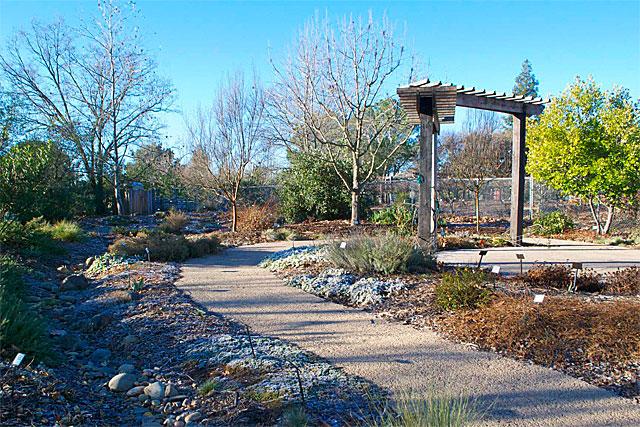
Days are shorter, nights are cooler, the sun lower in the sky, leaves have fallen and rain has washed off the garden leaving evergreens and dramatic bark, berries, grass stalks and twigs to glisten. The garden is peaceful and quiet. Pollinators venture out on warm, sunny afternoons to check out the occasional rosemary, salvia, manzanita and other cool weather blooms.
While the garden appears to be at rest, not all is dormant. January is a busy month. Many natives are quietly budding out and starting their bloom cycle including the manzanita shrubs 'Howard McMinn' and 'Dr Hurd'. Non-native early winter bloomers including Grevillea lanigera 'Coastal Gem’, Narcissus 'Early Sensation’ and bush germander also brighten the landscape. Waving dry ornamental grass stalks, colorful woody stems, dry seed cases, toyon and Arbutus unedo ‘Compacta’ berries, and shining boulders and stones along the dry creek beds highlight the winter walkways.
January is a month of many garden tasks. While now is the time to prune dormant deciduous shrubs, trees and some perennials we will wait until February to work on the ornamental grasses. Along with pruning, many of the hard and soft wood cuttings, especially of the native toyon, ceanothus, coyote bush and manzanitas can be used to propagate new plants. It is also not too early to go after newly sprouting weeds while they are small and the ground is soft. While January historically is our wettest month, if the rainfall is below average, will consider irrigating many of our early blooming natives and new plantings.
Winter pruning can seem like a daunting task. Often all that is needed are clean, sharp tools to remove dead, diseased, damaged and/or crossing branches allowing air into the interior of the plant and to improve appearance. The University of California Integrated Pest Management and the University of California Garden Web websites are good places to find information on what specific plants require to encourage optimal growth and the proper place to make the pruning cut. Get more information at these links:
- Cultural tips for trees, shrubs, and woody plants
- Trees, shrubs and woody ornamentals
- Landscape Trees, Shrubs and Perennial Vines
- Rose culture and pruning
- Ornamental grass pruning (PDF 88.3K)
January is also a good time to review water drainage within the landscape. Our landscape includes permeable pavement, swales and dry creek beds that serve to filter runoff cleanly and directly into the landscape. See this video from the California State Water Board for information on storm water control.
This month is also the time to plan for the year ahead. We offer a good site to find publications for rainy day (or anytime) reading on a wide variety of garden issues written for Sacramento Gardeners.
Come check out the garden. In addition to the plants, pathways, patios, raised planters, drip irrigation, a dry creek bed and permeable pavement demonstrate water wise, sustainable alternatives for gardeners who are considering replacing or reducing their lawns.
| Arbutus unedo ‘Compacta’ Native to the coast of Ireland and along the Mediterranean coast as far as Israel, Arbutus unedo prefers dry summers. A versatile evergreen shrub or multi-trunked small tree, it tolerates a wide variety of soil types but must have good drainage to do well. Slow growing to 6 feet high and wide, this shrub will award the patient gardener with concurrent fall white blossoms and lovely berries that change from golden yellows to bright red that are set off by glossy green foliage and attractive maroon bark. Birds and bees are entranced by the buds and berries. Very drought tolerant once established and tolerant of some shade, this plant benefits from pruning that brings emphasis to the branching stems and bark. The berries are edible but tasteless. |
|
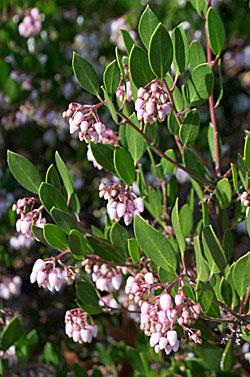
|
Arctostaphylos densiflora ‘Howard McMinn’ This durable California native, an upright shrub with handsome red bark, glossy leaves and winter blooming delicate pink blossoms, does well in the Sacramento County area. It accepts a wide variety of soils, handles pruning, can be grown in part shade, requires little summer water, and attracts hummingbirds and beneficial insects. Can grow 6 to 8 feet tall and wide. |
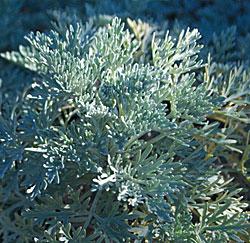
|
Artemesia x ‘Powis Castle’ This popular evergreen British hybrid perennial grows into to a silvery, lacy mound 3 feet tall and 6 feet wide. When the rest of the garden is dormant, ‘Powis Castle’ makes a bright silver statement. Flowers are insignificant. A splendid background for bright flowers of other plants, it is very tough. Provide good drainage and water two to three times a week the first year. Once established, it is drought tolerant and hardy. As the plant ages, it can become rangy and woody if not pruned to shape in fall or early spring. It also can be cut down to within 4 to 6 inches of the ground if needed to renew. |
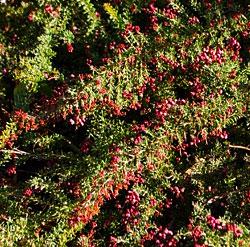
|
Grevillea lanigera 'Coastal Gem' Blooming as early as December and through winter into spring this low growing (1 foot tall by 4 feet wide), evergreen spreading shrub from Australia is extremely drought tolerant. It is also deer resistant. Sometimes known as “woolly” grevillea due to its soft, gray green leaves, it makes a good border, rock garden or ground cover plant. We have it planted on a slope (to improve drainage) at the entrance of our perennial path. Preferring full sun and neutral to slightly acidic fertile well drained soil, it can also handle some light shade in our climate. |
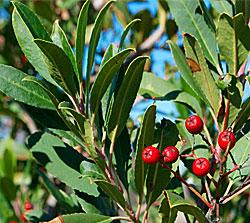
|
Heteromeles arbutifolia Found at the entrance of the Native garden, this evergreen native rose family large shrub (or small multi-trunked tree) carrying the name given by the Ohlone, toyon, bears gorgeous clusters of red berries on stems of glossy, leathery leaves just in time for the holiday season. Unpalatable until the berries have ripened and fermented many birds will have their own tipsy holiday feast on these brilliant berries. Abundantly found in chaparral and woodlands from Humboldt County to Baja California and in the Sierras below 4000 feet it is also known as or Christmas berry or California holly. It is the namesake of the city of Hollywood. Toyon is usually grown as a large accent shrub or small multi-trunked tree. Mature plants can be 8 to15 feet tall and wide. Adaptable to a wide range of soils, moisture conditions and exposure, it does best with good drainage and only light shade. Hedging and hard pruning is not recommended and young specimens up to 2 years may be more vulnerable to pathogens but once established, toyons are long lived and low-maintenance. Plants can harbor low levels of many pests, including aphids, scale, mealy bugs but usually they do not cause significant damage to established specimens. Clusters of small white blossoms mature to berries in winter. While we have planted our toyon as an accent plant with Spreading California aster, California fuchsia and Cleveland sages, it also can be combined in a shrub grouping with other California natives such as manzanitas and ceanothus. A UC Davis Arboretum All-Star selection. |
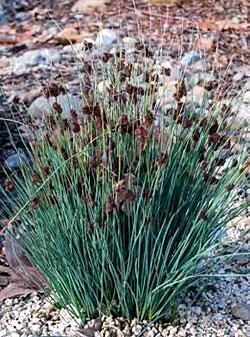
|
Juncus patens 'Carman's gray' Sited in a low spot at the entrance to the WEL native garden patio, is the evergreen perennial rush, Juncus patens ‘Carman’s gray’. Similar to ornamental grasses and sedges, rushes are distinguished by dense, cylindrical, upright rigid fine stems. Juncas patens is native to moist habitats below 5000 feet in Oregon and California where it is found along stream beds and in other moist areas. Also known as wire grass, the stiff stems were often used as foundation material in Native American baskets. Juncus patens is easy to grow and not particular about soil but prefers moist/wet areas and full sun. However it adapts well to low summer water and part shade. We have planted ours in a location where water often puddles after rains or irrigation. This is a good plant choice for rock gardens, meadows and dry streambed features. Slow growing first as a dense clump and then spreading into drifts with inconspicuous flowers it can be cut to the ground in late fall or winter to rejuvenate as needed. All cultivars are easy to grow. They are named for their stem coloring. |
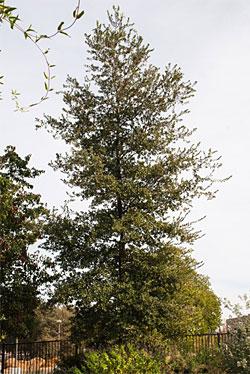
|
Quercus douglasii Midway along the Fair Oaks Horticulture Center parking lot fence is our resident blue oak. It is most likely a hybrid volunteer cached then forgotten by a scrub jay. It has been happily growing for at least 10 years. With a life expectancy of 175 to 450 years, this slow growing young potential totem could reach from 20 to 65 feet and watch over the water-efficient landscape for many years to come. Native to our foothills between 500 to 2000 feet, blue oaks are very drought tolerant. Acorns are knobby capped with smooth inside shells.Their bluish leaves can be lobed or unlobed with smooth or toothed margins. Wind pollinated, they readily hybridize with several other members of the white oak subspecies. Normally deciduous, in warmer areas foliage may linger until spring. Native habitat includes gravelly and rocky slopes and thin, well drained soils. They may go summer dormant and shed their leaves in dry years. In colder areas they exhibit fall color, but our oak isn’t especially noteworthy in the fall. In the Sacramento region they would be especially well suited for dry sites with rocky infertile soils at least 12 inches deep. For more information about growing oaks in the urban landscape see University of California Oak Woodland Management. |
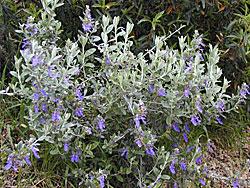
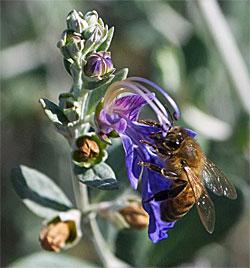
|
Teucrium fruticans 'Azureum' This UC Davis All-Star shrub starts blooming in January just in time to attract early foraging bees and other pollinators on warm days. Extremely durable, disease free and drought tolerant this western Mediterranean small shrub with gray green leaves and a long fall/ winter/spring blooming season can be pruned as a low hedge or used as an accent plant. The lovely purple/lavender blossoms attract many beneficials. |




